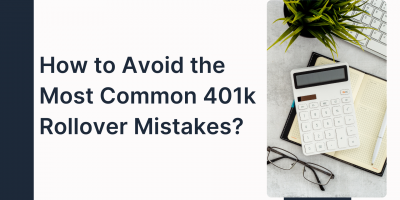
How to Avoid the Most Common 401(k) Rollover Mistakes?
Just switched jobs? What you do with your 401(k) next could either save or drain thousands from your retirement.

Imagine what a sales team could do if it knew exactly who was researching their product, when they were conducting that research.
With intent data, sales teams can reach prospects armed with all the necessary information before making the first move. With such data sources, a company’s sales professionals, marketers, and retention specialists have the data to pursue the course of action that closes the deal.
Approximately 60% of B2B buyers have already decided before contacting a salesperson. With prospects moving rapidly down the funnel, companies lose the chance to interact with them in a timely fashion. And without valuable data of where your prospects are and what they are searching, you risk targeting them at the wrong stage in their buyer’s journey – or missing them altogether.
Unsurprisingly, the first person in the door wins the business 80% of the time. Thus, companies use buyer data to better understand their customers, unveil their interests, and close more deals.
Understanding the B2B buyer journey translates to numerous benefits for both marketing and sales teams. With buyer intent data, they will be better able to generate new, qualified leads and increase sales conversions.
Simply put, intent data is a collection of information about prospects and their online activity. Whether this information collection refers to a company’s activity or individual users differentiates between B2B or B2C intent data.
89% of people conduct extensive individual research before making a (B2B) purchase. The good news is that this research provides companies and teams with subtle buying signals. These aggregated behavioral signals allow you to identify buyers through their B2B purchase journey.
Intent data uses behavioral signals from specific sources across categories and topics. Those signals indicate the purchase intent through different activities that might include:
Intent data is every signal and activity that indicates the readiness of a lead for a purchase.

B2B intent data helps companies grow their pipeline of qualified leads. Furthermore, it provides sales and marketing teams with useful insights to conduct effective marketing strategies, precise segmentation, and personalized outreach.
B2B intent data is a powerful tool to supercharge account-based marketing strategies.
In addition to other data analytics tools marketers use, B2B intent data creates a holistic understanding of prospects’ behavior and intent. They can determine whether a prospect has:
Even though users’ behavioral signals create a massive dataset, B2B intent data pinpoints the importance of quality over quantity.
Only 16% of marketers say that their outbound work provides the highest quality leads, challenging marketing teams. However, by using B2B intent data, marketing teams can better understand prospects’ intent (and leverage it to their advantage) based on:
The main sources of intent data include website data, content consumption data and content interactions, off-site activity, CRM, social media data, and more. This data can be collected in-house or by a third-party provider. Moreover, according to the method used for data collection, we have internal or external buyer intent data.
Internal buyer or first-party data is collected through owned marketing automation platforms, websites, web tracking apps, or within owned software.
External buyer data or third-party data is data collected from companies using external sources such as IP address lookup, cookies, B2B websites, other specific websites, media publishers, and more.
The main difference between both is that the dataset sourced by the internal data is unique and available only to those who own the website. On the other hand, the external dataset is managed and owned by the platform that provides it. External buyer intent data is typically available for purchase, often with a subscription.

Research shows that only 3% of your potential buyers are actively looking for solutions or products online at a given time. Some are already in the middle stages of the funnel (interest and consideration) and exposed to more competitors as they are doing more profound research. Others aren’t even thinking about your product.
By leveraging intent data, companies can get involved in the early stage of the buyer’s journey and gain an advantage over their competitors. With prospective buyers doing a larger percentage of their research online than ever before without talking to sales reps, having this data is extremely valuable.
Intent data is applicable across many departments, and it can be used as a booster for sales and marketing strategies, or customer success and retention. It can help marketing and sales teams surface qualified leads, improve outbound pitches, create more personal ABM (Account–Based Marketing) campaigns, reduce churn rate, and more.
Buyer intent data can be broadly used by marketing teams in helping them find qualified leads, identify early buyer interest, create personalized campaigns and content, guide marketing messaging, and much more.
The intent dataset can indicate the presence of a prospect and what the prospect is interested in, and the readiness to make a purchase. Buyer intent data can help identify prospects’ pain points, allowing marketing teams to offer a solution and build a good relationship even before prospects become customers.
Marketing professionals can benefit from intent data by improving ABM and content campaigns and target account lists with personalized messages.
By using buyer intent data, marketers can provide sales teams with a list of qualified leads. That can supercharge the sales teams with information about who is interested in their offer and what they are interested in.
This information helps teams reach prospects in the early stage of their buying cycle before making a purchase decision. Based on intent data, sales teams can efficiently prioritize outreach based on significant intent indicators and engage with them at the right time.
Moreover, your sales team can leverage intent data to detect early buyer interest and convey more efficient prospecting.
Buyer intent can help retain existing clients by analyzing their actions. Different customer success triggers can show when customers are experiencing levels of dissatisfaction and lack of value. Thus, the intent dataset can identify these users, and customer success and retention teams can pay special attention and create strategies to help them.
Customer success reps can use intent data to create long-term customer relationships and reduce churn.
There are numerous benefits of using intent data in sales and marketing by uncovering the users’ intent and responding to customers’ needs. This type of marketing helps teams better understand prospects, align content with their pain points, and ultimately close more deals.
Some of the most valuable benefits include:
In conclusion, buyer intent data is a cutting-edge intelligence tool that changes how companies identify and interact with prospects. The customer-based approach of intent data developed to understand prospects’ needs and pain points allows companies to reach them through the funnel and offer adequate solutions.
Ultimately, companies use buyer intent data to understand their prospects, engage with them through their buyer journey, take care of their existing customers, and have an unparalleled advantage over their competitors.
3% Rule: Engage Customers Before They Need Your Services | Sticky Branding
Resource – What is Buyer Intent Data: The Ultimate Guide (internalresults.com)
What Is Buyer Intent Data? (and How Can I Operationalize It?) – Terminus Site
What Is Buyer Intent Data? How Can I Increase Sales With It? (leadiro.com)
What Is Intent Data? And How Is it Collected? | The Pipeline | ZoomInfo
Browse our curated list of vendors to find the best solution for your needs.
Subscribe to our newsletter for the latest trends, expert tips, and workplace insights!

Just switched jobs? What you do with your 401(k) next could either save or drain thousands from your retirement.

Calculating your savings isn’t easy. Discover how to estimate monthly retirement income and how many years it will last.

From emerging technologies and the wealth transition to a shift in growth and tax strategies, here are the most significant investment management trends shaping 2024.

Could stock options be the decision that transforms your career into a life-changing investment opportunity?
Used by most of the top employee benefits consultants in the US, Shortlister is where you can find, research and select HR and benefits vendors for your clients.
Shortlister helps you reach your ideal prospects. Claim your free account to control your message and receive employer, consultant and health plan leads.